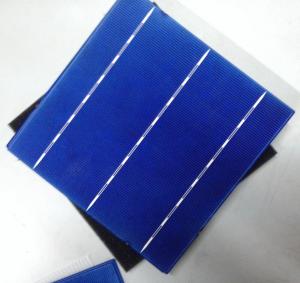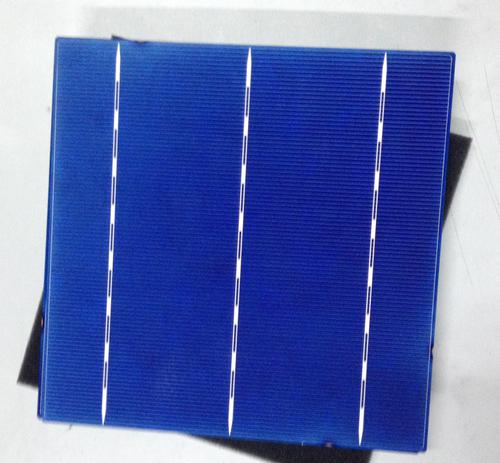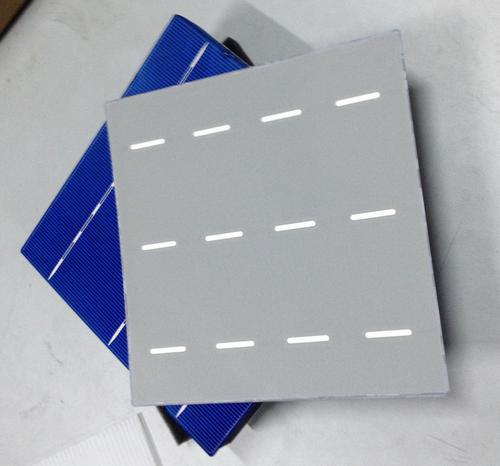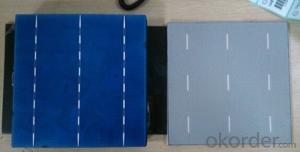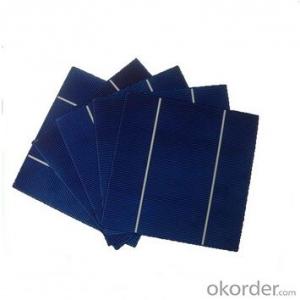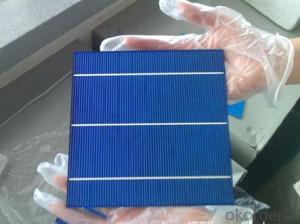Polycrystalline Silicon Solar Cell Type CSUN-M156-3BB-96
- Loading Port:
- China Main Port
- Payment Terms:
- TT or LC
- Min Order Qty:
- 5000 pc
- Supply Capability:
- -
OKorder Service Pledge
OKorder Financial Service
You Might Also Like
1. Structure of Polycrystalline Silicon Solar Cell Type CSUN-M156-3BB-96
A solar cell is an electrical device that converts the energy of light directly into electricity by the photovoltaic effect, which is a physical and chemical phenomenon. It is a form of photoelectric cell, defined as a device whose electrical characteristics, such as current, voltage, or resistance, vary when exposed to light. Solar cells are the building blocks of photovoltaic modules, otherwise known as solar panels. Solar cells are often electrically connected and encapsulated as a module. Photovoltaic modules often have a sheet of glass on the front (sun up) side, allowing light to pass while protecting the semiconductor wafers from abrasion and impact due to wind-driven debris, rain, hail, etc. Solar cells are also usually connected in series in modules, creating an additive voltage. Connecting cells in parallel will yield a higher current; our solar cells have passed IEC Certification. With high and stable quality, our cells can greatly improve the performance of Solar Modules.
2. Main Features of Polycrystalline Silicon Solar Cell Type CSUN-M156-3BB-96
1. Tire-1 Solar Cells’ Manufacturer Quality Guarantee. With a complete and sophisticated quality government system, our Quality Management have arrived world’s leading place. Customer can receive Tire-1 Cells Maker’s Quality Standard Products.
2. Trusted Warranty. We can supply trusted after-sales service to our customer. If our cells are found not in conformity to the specification of manufacturer, or should the inspected quantity found in shortage, or should the packing found damaged, the buyer has the right to claim to the seller. The claim, if any, should be presented to seller within 30 days after cargo's arrival date to the port, together with related inspection report and photos issued and provided by a reputable independent surveyor such as SGS.
3. World’s Leading Manufacturer Equipment. We imported the newest and leading production equipment from abroad. Advanced equipment can guarantee the stable quality of cells. Auto production line can also save labor cost which will further cut our production cost.
4. Bulk supply: With the production capacity of 500MW, we can produce large quantity every month. This can satisfy most customer requirement.
3. Polycrystalline Silicon Solar Cell Type CSUN-M156-3BB-96 Specifications
Format : 156 mm × 156 mm ± 0.5 mm
Thickness: 200 μm ±20 μm
Front (-) : 1.4mm bus bars (silver),blue anti-reflection coating (silicon nitride)
Back (+) : 1.8mm wide soldering pads (silver) back surface field (aluminium)
Efficiency (%) | Pmpp (W) | Umpp (V) | Impp (A) | Uoc (V) | Isc (A) | FF(1%) |
17.80-17.95 | 4.33 | 0.531 | 8.159 | 0.629 | 8.681 | 79.31 |
17.70-17.80 | 4.30 | 0.529 | 8.146 | 0.628 | 8.661 | 79.18 |
17.60-17.70 | 4.28 | 0.526 | 8.137 | 0.627 | 8.640 | 79.05 |
17.50-17.60 | 4.26 | 0.524 | 8.121 | 0.626 | 8.625 | 78.87 |
17.40-17.50 | 4.23 | 0.522 | 8.105 | 0.625 | 8.611 | 78.67 |
17.30-17.40 | 4.21 | 0.520 | 8.095 | 0.624 | 8.601 | 78.42 |
| 17.20-17.30 | 4.19 | 0.518 | 8.077 | 0.623 | 8.571 | 78.39 |
| 17.10-17.20 | 4.16 | 0.518 | 8.037 | 0.621 | 8.555 | 78.32 |
4. Polycrystalline Silicon Solar Cell Type CSUN-M156-3BB-96 Images
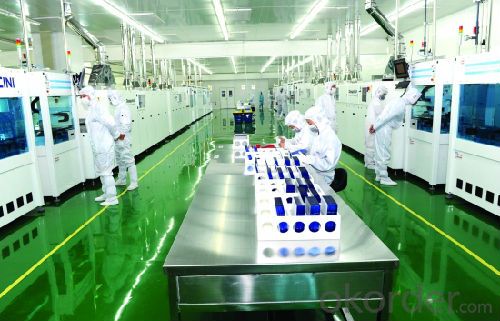
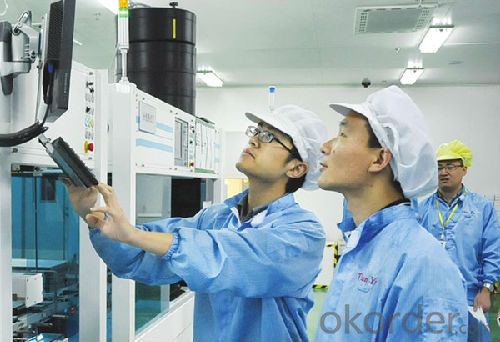

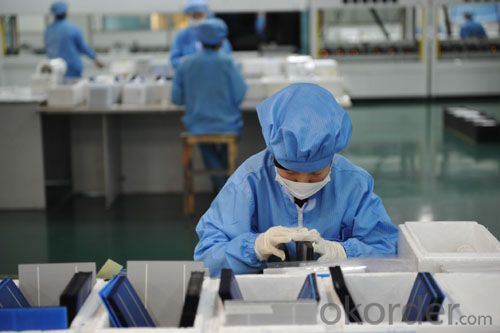
5. FAQ
Q1. How should you deliver the solar cells?
Re: We use carton box for packaging and deliver the solar cells by air in order to avoid the sunlight and moisture for the maximum degree.
Q2. How is your production and quality control?
Re: We use standard cells calibrated by Fraunhofer ISE and peel strength control.
- Q: How do solar cells impact greenhouse gas emissions?
- Solar cells have a significant positive impact on greenhouse gas emissions as they generate electricity without producing any greenhouse gases. The use of solar energy reduces our reliance on fossil fuels, which are major contributors to greenhouse gas emissions, thereby helping to mitigate climate change.
- Q: What is a thin-film solar cell?
- A thin-film solar cell is a type of solar cell that is made using very thin layers of semiconductor materials. These layers are typically only a few micrometers thick, which makes the solar cell much lighter and more flexible compared to traditional solar cells. Thin-film solar cells are less efficient at converting sunlight into electricity but are more cost-effective and can be used in a wider range of applications.
- Q: What is the impact of temperature fluctuations on solar cell efficiency?
- Temperature fluctuations can have a significant impact on solar cell efficiency. As temperature increases, the efficiency of solar cells tends to decrease. This is because higher temperatures can cause an increase in the resistance of the materials used in solar cells, leading to a decrease in the overall power output. Additionally, temperature fluctuations can also lead to thermal stress and expansion, which can potentially damage the solar cells and further reduce their efficiency. Therefore, it is important to consider and manage temperature fluctuations to optimize the performance of solar panels.
- Q: Can solar cells be used for powering remote weather monitoring stations?
- Yes, solar cells can be used to power remote weather monitoring stations. Solar cells are a reliable and sustainable source of energy that can convert sunlight into electricity. They can be installed in remote areas where access to the power grid is limited or non-existent, providing a consistent power supply to operate weather monitoring equipment. Additionally, solar cells require minimal maintenance and have a long lifespan, making them a practical choice for powering remote weather monitoring stations.
- Q: What is a solar cell?
- A solar cell, also known as a photovoltaic cell, is a device that converts sunlight directly into electricity using the photovoltaic effect. It consists of a semiconductor material that absorbs photons from sunlight, generating an electric current as a result.
- Q: How are solar cells connected in a photovoltaic system?
- Solar cells are connected in a photovoltaic system in series or parallel configurations to generate the desired voltage and current output.
- Q: What is the environmental impact of solar cell production?
- The environmental impact of solar cell production is relatively low compared to other forms of energy production. While the extraction and processing of raw materials required for solar cell production can have some environmental consequences, such as land disturbance and water pollution, the overall impact is minimal. Additionally, the use of solar energy reduces greenhouse gas emissions and dependence on fossil fuels, making it a sustainable and environmentally friendly option for energy generation.
- Q: Can solar cells be used in educational institutions?
- Yes, solar cells can be used in educational institutions. They offer a hands-on approach to teaching students about renewable energy and the importance of sustainable practices. By installing solar panels on rooftops or in designated areas, educational institutions can generate clean energy, reduce their carbon footprint, and save on electricity costs. Additionally, incorporating solar cells into the curriculum allows students to understand the science, technology, and environmental aspects of solar energy, fostering a greater awareness and understanding of renewable energy sources.
- Q: Can solar cells be used in desalination plants?
- Yes, solar cells can be used in desalination plants. Solar energy can be harnessed to power the desalination process, providing a sustainable and environmentally friendly solution to address the growing global water scarcity issue.
- Q: Can solar cells be used in indoor applications?
- Yes, solar cells can be used in indoor applications. While solar cells primarily generate electricity from sunlight, they can also convert artificial light sources, such as fluorescent or LED lighting, into electricity. This makes them suitable for powering various indoor devices and applications, including calculators, wireless sensors, and even indoor lighting systems.
Send your message to us
Polycrystalline Silicon Solar Cell Type CSUN-M156-3BB-96
- Loading Port:
- China Main Port
- Payment Terms:
- TT or LC
- Min Order Qty:
- 5000 pc
- Supply Capability:
- -
OKorder Service Pledge
OKorder Financial Service
Similar products
Hot products
Hot Searches
Related keywords


